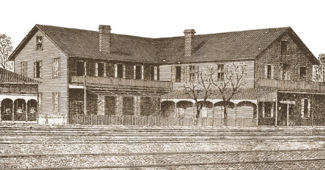Relay House: Difference between revisions
mNo edit summary |
No edit summary |
||
| Line 1: | Line 1: | ||
:''This article is about the 19th century hotel, for the private club, see [[Relay House club]].'' | :''This article is about the 19th century hotel, for the private club, see [[Relay House club]].'' | ||
The '''Relay House''' was a two-story, | [[Image:Relay House.jpg|right|thumb|325px|An engraving of the Relay House]] | ||
The '''Relay House''' was a two-story, "L"-shaped wood frame hotel built by the [[Elyton Land Company]] in [[1871]] at the corner of [[Morris Avenue]] and [[19th Street North]] adjacent to the [[Railroad Reservation]]. As a means of restricting the corporation's power under the law, the building and its "necessary outhouses" were the only structures that would be erected by the Elyton Company under its articles of incorporation. Its name was chosen by [[James R. Powell]] who operated a mail coach from the hotel. | |||
A Mr Masterson was engaged to see to its construction. Although by charter, its construction was not to exceed $10,000 in cost, the final bill totaled $13,974.08. The building's exterior was wrapped with deep verandas which served as waiting and greeting areas for trains. Features of the hotel included gas fixtures, earth closets and a large cistern for water. Bells in each of the 37 rooms sounded in the office. | |||
The hotel | The Relay House was actually the new city's second hotel. It opened under the management of [[William Ketchum]] on [[December 15]], 1871 and quickly became the social center of the young city. It served as a train station and gathering place for people doing business. Ketchum was assisted by his wife [[Jane Ketchum|Jane]] and by his son-in-law, [[George Robert Ward]], the grandfather of future mayor [[George Ward]], along with his wife [[Margaret Edith Ketchum Ward]]. Mrs Ward hosted many of the city's early social events at the hotel. | ||
On November 15, [[1883]] the hotel hosted hearings of the United States Senate Committee on Relations Between Labor and Capital, at which Mrs Ward was a star witness. | On [[November 15]], [[1883]] the hotel hosted hearings of the United States Senate Committee on Relations Between Labor and Capital, at which Mrs Ward was a star witness. | ||
The Relay House was demolished in [[1886]] to make room for | The Relay House was demolished in [[1886]] to make room for the new [[L & N Station]]. | ||
==References== | ==References== | ||
* White, Marjorie Longenecker, ed. (1977) ''Downtown Birmingham: Architectural and Historical Walking Tour Guide.'' Birmingham: Birmingham Historical Society. | * White, Marjorie Longenecker, ed. (1977) ''Downtown Birmingham: Architectural and Historical Walking Tour Guide.'' Birmingham: Birmingham Historical Society. | ||
* Blake, Thomas Harry (1972) ''Birmingham Since 1885''. Birmingham: Birmingham Historical Society. | |||
[[Category:Hotels]] | [[Category:Hotels]] | ||
[[Category:Morris Avenue|1999]] | [[Category:Morris Avenue|1999]] | ||
[[Category: | [[Category:19th Street North]] | ||
[[Category:1871 buildings]] | [[Category:1871 buildings]] | ||
[[Category:Demolished buildings]] | |||
Revision as of 00:06, 1 July 2007
- This article is about the 19th century hotel, for the private club, see Relay House club.
The Relay House was a two-story, "L"-shaped wood frame hotel built by the Elyton Land Company in 1871 at the corner of Morris Avenue and 19th Street North adjacent to the Railroad Reservation. As a means of restricting the corporation's power under the law, the building and its "necessary outhouses" were the only structures that would be erected by the Elyton Company under its articles of incorporation. Its name was chosen by James R. Powell who operated a mail coach from the hotel.
A Mr Masterson was engaged to see to its construction. Although by charter, its construction was not to exceed $10,000 in cost, the final bill totaled $13,974.08. The building's exterior was wrapped with deep verandas which served as waiting and greeting areas for trains. Features of the hotel included gas fixtures, earth closets and a large cistern for water. Bells in each of the 37 rooms sounded in the office.
The Relay House was actually the new city's second hotel. It opened under the management of William Ketchum on December 15, 1871 and quickly became the social center of the young city. It served as a train station and gathering place for people doing business. Ketchum was assisted by his wife Jane and by his son-in-law, George Robert Ward, the grandfather of future mayor George Ward, along with his wife Margaret Edith Ketchum Ward. Mrs Ward hosted many of the city's early social events at the hotel.
On November 15, 1883 the hotel hosted hearings of the United States Senate Committee on Relations Between Labor and Capital, at which Mrs Ward was a star witness.
The Relay House was demolished in 1886 to make room for the new L & N Station.
References
- White, Marjorie Longenecker, ed. (1977) Downtown Birmingham: Architectural and Historical Walking Tour Guide. Birmingham: Birmingham Historical Society.
- Blake, Thomas Harry (1972) Birmingham Since 1885. Birmingham: Birmingham Historical Society.
